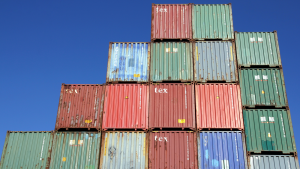Indeed, 2024 has effectively ushered in a topsy-turvy period for global supply chains. Major Panama and Suez Canal disruptions and escalating geopolitical tensions reshape decades-old trade routes.
In particular, retailers are feeling the heat of these major upheavals, especially with the continuing attacks in the Red Sea. Those impact Suez Canal accessibility, a critical route for East Coast U.S. and European markets. Amidst these challenges, businesses are forced to adapt. This leads to a growing focus on supply chain stocks to sell as they navigate these challenging waters.
Therefore, let’s delve into the growing complexities and potential strategies for investors in the face of the global supply chain conundrum.
Hapag-Lloyd (HLAGF)

Hapag-Lloyd (OTCMKTS:HLAGF) is a prominent name in shipping, confronting a turbulent future marked by growing challenges.
The firm’s struggles aren’t isolated though. They mirror a sector-wide downturn characterized by dropping freight rates and soaring operating costs. This new year looms with further operating woes, driven by a capacity glut, a hangover from misjudged pandemic-era demand predictions. The firm’s latest financials paint a rather grim picture. A startling 58% year-over-year (YOY) plunge in freight rates dwarf the uptick in volume. Hapag-Lloyd’s revised guidance sharply reflects this stark downturn, signaling deepening losses amid an unbalanced supply-demand equation.
Amidst this financial maelstrom, Hapag-Lloyd grapples with the direct impacts of the Red Sea crisis. Continuing militant threats have compelled the shipping giant to divert its vessels via the Cape of Good Hope. And this adds thousands of miles to journeys while exacerbating operational costs. This strategic reroute, a response to aggressive attacks on commercial shipping by Yemeni rebels, shakes a trade artery handling 12% of global commerce. The result is heightened shipping costs, delayed deliveries, and a spike in consumer costs.
Tesla (TSLA)

EV trailblazer Tesla (NASDAQ:TSLA) finds itself navigating a stormy sea of supply chain disruptions.
This unforeseen challenge has compelled the EV juggernaut to temporarily halt production at its German Gigafactory. And this exacerbates its precarious position amidst labor strikes, stiff competition, and waning revenues in Europe. The impact is not just logistical but strikes at the core of Tesla’s operational efficiency. In fact, it casts a shadow over its robustness in the face of adversity.
Moreover, Tesla’s latest fiscal performance paints a rather grim picture, with Q4 results missing targets on key financial metrics. The necessity for aggressive price cuts to push an impressive 1.8 million vehicle deliveries signals a deeper issue. That’s a struggle for top and bottom-line growth which is hard to ignore. Analysts are taking note, revising sales forecasts downward. Tesla’s high P/E ratio of 57 times looms large, triggering skepticism among investors. This cocktail of challenges, from supply chain snags to financial underperformance, positioned Tesla at a precarious crossroads.
C.H. Robinson Worldwide (CHRW)

C.H. Robinson Worldwide (NASDAQ:CHRW) is another top player in freight transportation and logistics. It is sailing into stormy waters, aggravated by the ongoing Red Sea crisis.
The firm’s third-quarter performance in 2023 was a harbinger of challenges. It showed a steep revenue decline and a sharp 61.8% drop in net income per share. The Red Sea conflict further intensifies these woes, leading to stressed ocean capacity and a scramble for inadequate resources.
Now, the company is caught in the crossfire of global logistics disruptions, facing major challenges in the Asia-Europe trade lane and beyond. The rerouting of vessels from the Suez Canal has effectively triggered a domino effect. This stretches CHRW’s resources thin and forces it toward alternative, less efficient logistics strategies such as air freight and LCL ocean shipping. As the firm grapples with these unprecedented challenges, the future looks remarkably uncertain. Therefore, it paints a rather bleak picture for investors and stakeholders alike.
On the date of publication, Muslim Farooque did not have (either directly or indirectly) any positions in the securities mentioned in this article. The opinions expressed in this article are those of the writer, subject to the InvestorPlace.com Publishing Guidelines.
